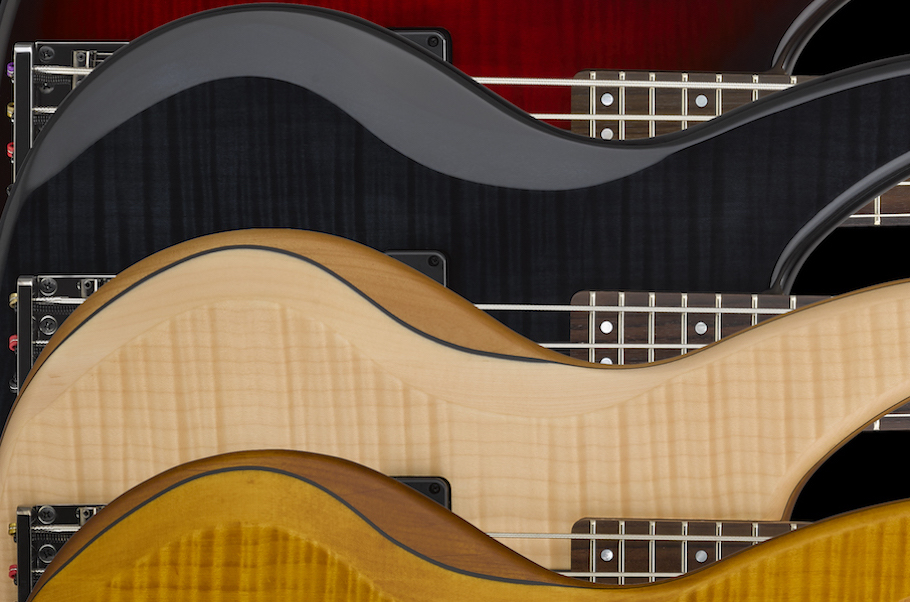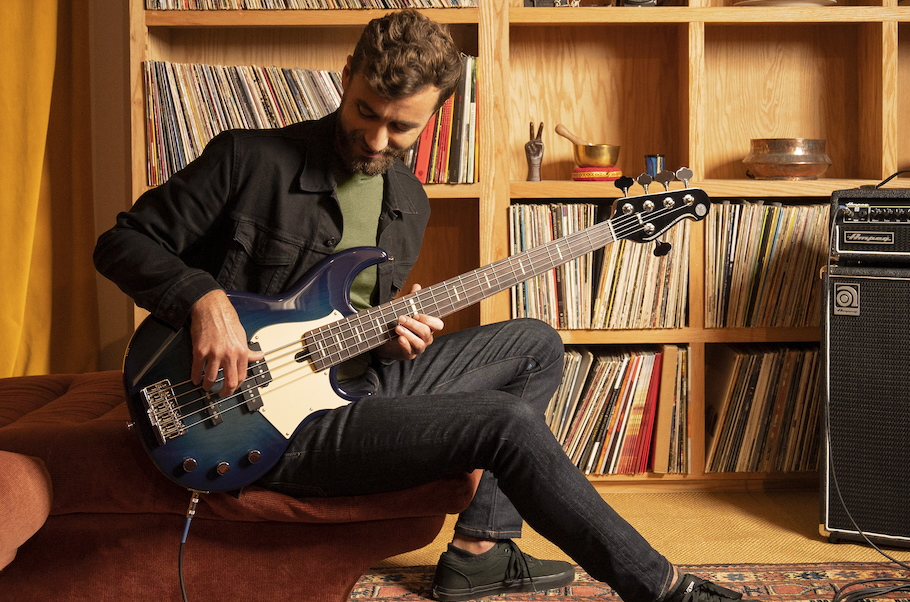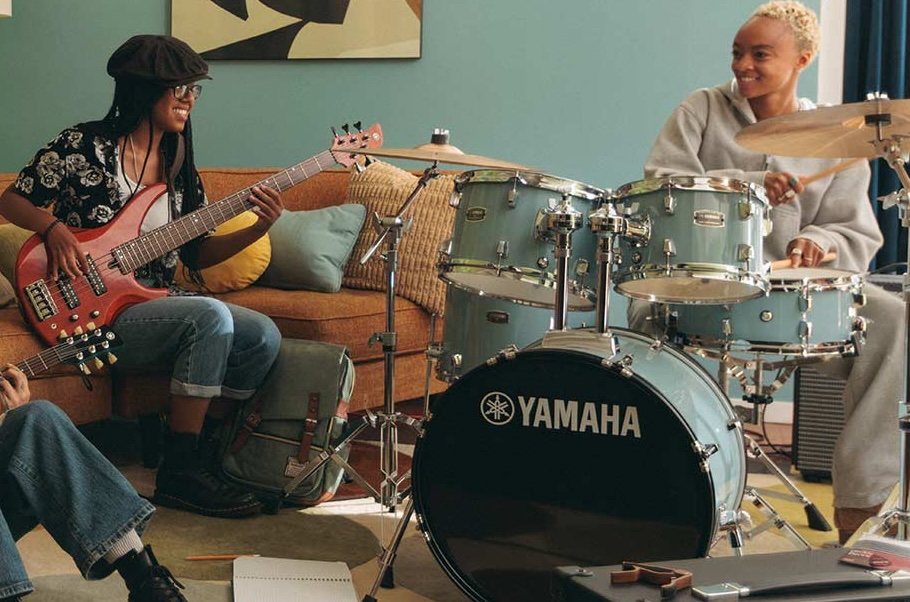Step Up to a Better Bass
What to look for when you’re ready to take things to the next level.
Many beginner basses are fairly well built and relatively easy to play, but they can be limiting for players who want more refined qualities and the kind of playability and tonal flexibility that a starter instrument simply can’t deliver. Here are some key reasons why you should consider stepping up to a better bass.
Better Tone
One area where intermediate- and professional-level basses tend to offer a distinct improvement is the selection of tonewoods used for their bodies and necks — a factor that has a huge impact on sound quality. With beginner basses, manufacturers often utilize non-traditional, cost-effective options, but “step-up” basses are almost always constructed from premium tonewoods.
For example, Yamaha BB400 Series basses like the four-string BB434 and five-string BB435 feature alder bodies for strong, full-focused mids and lows, along with a five-piece maple/mahogany bolt-on neck topped with a rosewood fingerboard for crisp highs coupled with the earthy warmth of mahogany and rosewood. The BB434M model features the same construction, except it comes equipped with a maple fingerboard for a slightly brighter tone.
All three BB400 models benefit from a bridge that incorporates diagonal “body-through” stringing for improved transfer of string vibrations to the body. They also utilize a unique six-bolt miter neck joint design, which can be found on many higher-end Yamaha basses. This holds the neck closer and tighter to the body than standard bolt-on designs. It’s a subtle feature that could easily be overlooked, but it’s important since that joint is the critical connection point where vibrational energy is transferred from the neck to the body.
If you’re in search of that deep “played-in” bass sound, you should consider stepping up to a Yamaha BB Pro Series bass such as the four-string BBP34 or five-string BBP35. These utilize the company’s proprietary Initial Response Acceleration (I.R.A.) technology, which accelerates the maturation of the basses by applying specific vibrations during the manufacturing process. These vibrations release the stresses between the wood and finish, neck and fingerboard, and body and hardware to deliver better sound and playability. Whenever I play my BBP34, I’m struck by how perfect it sounds … and I suspect this treatment is a big part of the reason why.

Better Feel
Perhaps the biggest difference between a starter bass and an intermediate or pro model lies in the feel of the instrument — things like the contours of the body, how it balances around your neck when slung over your shoulders, and the comfort of the neck’s profile, curvature, width and thickness from the nut all the way up to the upper register where the neck meets the body.
Manufacturers of starter basses must make difficult sacrifices in order to be able to produce a great beginner instrument at a low price point. This often means you get a solidly built bass with a simpler approach that bypasses some finer details. Yamaha TRBX600 Series basses provide a great example of what you may have been missing out on. Both the TRBX604FM four-string and TRBX605FM five-string models sport a curvaceous alder/maple laminate body that’s carefully sculpted to nestle up against you (rather than bang into you) while playing. Furthermore, they hang perfectly balanced around your shoulders — and when a bass’ weight is well-distributed, it leaves you free to focus on playing rather than worrying about lower back pain after standing upright for an entire set.

TRBX600 Series basses also feature a super-comfy neck design with a satin polyurethane finish that’s fast to the touch and a profile that enables easy access to the upper frets without requiring hand contortions and awkward stretches. It feels right wherever you are on the neck — not too skinny, not too fat — making it a great choice for whatever style of music you play.
Better Looks
Whether it’s a worn-in pair of shoes or an older car that gets great mileage and never breaks down, there’s a soft spot in my heart for function over form. But when I can get my hands on function and form at the same time, sign me up — who wouldn’t want a great-looking bass that plays and sounds great?
To my eyes, the Yamaha TRBX Series basses qualify as serious eye candy (as well as being top-notch instruments), particularly the ones with the flamed maple tops, such as the aforementioned TRBX604FM and TRBX605FM models. No matter which finish you choose — translucent black, dark red burst, gloss polyurethane, matte amber or natural satin — it’s enough to get my heart pumping.

I’m also a sucker for Yamaha Signature basses such as the Attitude 30th and Attitude Limited 3 (both Billy Sheehan models), as well as the John Pattituci TRBPH2, Nathan East BBNE2 and Peter Hook BBPH, in part because of their looks. Breathtaking beauty is to be expected from highly customized instruments such as these, and they all deliver just that.
Better Craftsmanship
It almost goes without saying that the better the bass, the better the craftmanship that goes into it. My favorite way to demonstrate this to friends is to put my Yamaha BBP34 in their lap with the neck joint facing upward and point out how perfect it is. No gaps, no wiggling in the pocket, no uneven tolerances — it’s dead-on.
When it comes to basses (in fact, when it comes to most musical instruments), you often get what you pay for. When you step up to a higher-level bass, you’ll notice the difference in craftsmanship, which, along with other factors we’ve discussed (such as choice of tonewood, as well as things like neck design and bridge type), leads to improved tonal quality.
Better Technology
You’re more likely to encounter features like extra tone controls, extra pickups and active electronics (as opposed to passive) in a “step-up” bass. Intermediate- and professional-level basses also tend to have better quality pickups than starter instruments. For example, the YGD Custom V5 pickups found in Yamaha BB400 Series basses have been tweaked to deliver the classic BB Series vintage tone, along with the capability to dial in extra brightness to cut through the mix in live performances. And then there are the advanced Yamaha technologies we’ve already discussed — like I.R.A. and a six-bolt miter neck joint design — which come standard in many premium Yamaha basses.
So if you find yourself unable to stop listening to the voices in your head telling you that you’re ready to graduate from your starter bass to a better instrument, give in! You’re bound to find a new axe that will excite and inspire you … and there’s nothing wrong with that.
Check out these related blog articles:
A Brief Guide to Bass Guitar Tonewoods
Bolt-On vs. Neck-Through Basses
Exploring the Yamaha Signature Basses
Here are the New Peter Hook and Billy Sheehan Signature Basses
Choosing the Right Bass Guitar: Active vs. Passive
Click here for more information about Yamaha basses.




















